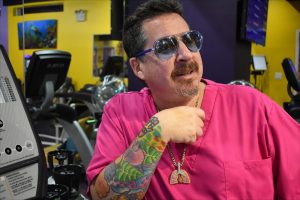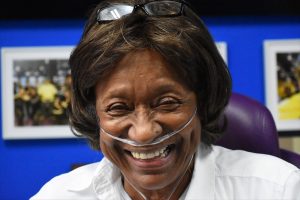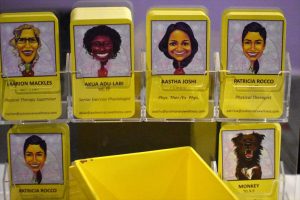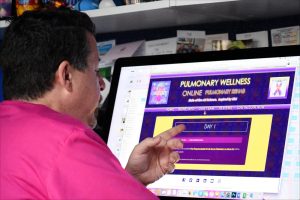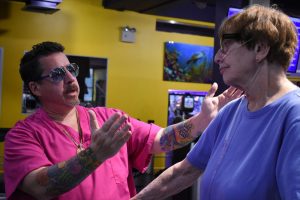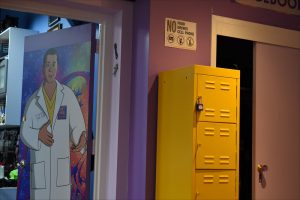‘Colorful’ Therapist Uses Exercise to Improve Patients’ Lives at NYC Pulmonary Rehab Clinic
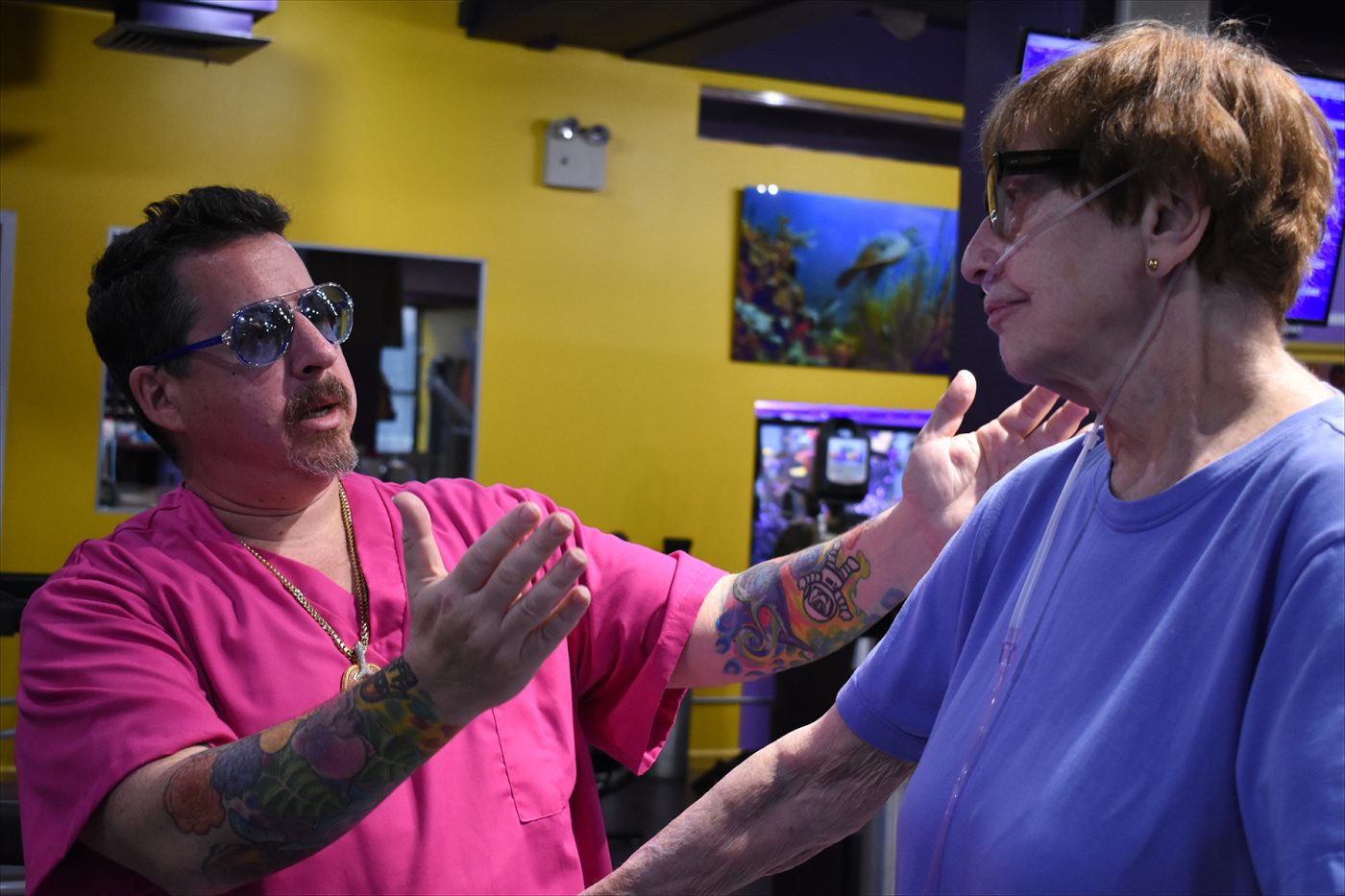
Noah Greenspan encourages 83-year-old Nancy Schlick of Brooklyn Heights, who has COPD. Greenspan’s Pulmonary Wellness Center in New York treats patients with COPD, pulmonary fibrosis and pulmonary hypertension.
Only a year ago, Florence Attaway — for decades a half-pack-a-day smoker — struggled to walk even one city block.
“I had to take a taxi from my home one block to the hospital because I could hardly breathe,” said the 83-year-old New Yorker, who has chronic obstructive pulmonary disease (COPD) and asthma.
But since coming to the Pulmonary Wellness & Rehabilitation Center in midtown Manhattan — where she does treadmill and bicycle exercises for an hour every Tuesday and Thursday — Attaway has far more stamina.
“Now I can walk two blocks and even do housework,” she said. “If it weren’t for Dr. Greenspan, I wouldn’t be here.”
Like Attaway, Nancy Schlick of Brooklyn Heights is also 83, and also has COPD.
“I started smoking when I was 16,” said Schlick. “But the minute I got my diagnosis, I said I’d never smoke another cigarette. Then my husband died of lung cancer. I was destroyed. I went back to cigarettes just to feel better.”
Both women are patients of physical therapist Noah Greenspan, whose 10th-floor practice at Fifth Avenue and East 38th Street specializes in pulmonary fibrosis (PF) and pulmonary hypertension (PH) as well as COPD, though its services are open to anyone with acute or chronic respiratory disease. About 250 patients visit the clinic regularly, most of them coming twice a week. He also has tens of thousands of followers online.
Since its inception, the center has conducted more than 100,000 cardiopulmonary exercise sessions.
The Pulmonary Fibrosis News forums are a place to connect with other patients, share tips and talk about the latest research. Check them out today!
“I consider what I do more of a life mission than a job,” said Greenspan, who not only plays the piano, saxophone and harmonica, but is also a fashion designer and enjoys photographing sharks in his free time. In addition, he writes a monthly column for Pulmonary Fibrosis News. “When you see me, you see the art, the fashion, the science, and the music. I try to bring all of it into one existence.”
Bright colors are everywhere
To say that Greenspan’s clinic is a riot of colors would be a vast understatement. In fact, it’s the first thing a visitor notices upon emerging from the elevator and stepping into the waiting room.
Walls of hot pink, bright blue, and intense red surround the exercise machines in the middle of the clinic, along with lockers painted school-bus yellow. At the reception desk, brightly colored business cards with caricatures of each of his 10 employees vie for attention, along with a huge 120-gallon aquarium filled with electric-blue, orange, green, and red African cichlids.
As if that’s not enough, a life-size painting of Greenspan adorns his office door; Greenspan himself is a walking canvas, as both his arms are covered with colorful tattoos.
All this color is intentional, he said.
“Too often, when people are diagnosed with a chronic illness, they become that illness. They become this kind of monochromatic version of their former selves — totally devoid of art, music, fashion, culture, and fun,” he explained. “Their whole life becomes going to the doctor, taking their medicines, and focusing on what they can’t do. They become the victim, the needy one, the weak one, the sick one.”
Originally from Brooklyn’s Flatbush neighborhood, the 48-year-old physical therapist is a board-certified specialist in cardiovascular and pulmonary physical therapy and rehabilitation. He went to SUNY Upstate Medical University in Syracuse, N.Y., and later got a doctorate in physical therapy from Dominican College in Orangeburg, N.Y.
“We live in a society where we eat too much, we don’t exercise enough, and we are constantly on our phones,” Greenspan told Bionews Services, which publishes this website, during a recent interview at his clinic. “Exercise is so important. It’s the single best thing you could do for yourself after quitting smoking.”
‘As much oxygen as you need’
Greenspan hates cigarettes but admits to having smoked a total of two packs that lasted him through four years of high school.
“I think cigarettes should be illegal. They kill you,” he said. “Occasionally, I have patients who are still smokers. Some programs won’t allow you in if you smoke, but I don’t agree with that, because people already feel bad enough.”
He continued: “There’s a huge stigma associated with smoking. If I can take you in, I’ll give you a month to quit on your own, and if you can’t, you have to try one of my methods — chewing nicotine gum, lozenges, or even acupuncture. There’s no single formula.”
While 80% of COPD patients are smokers or former smokers, tobacco use is not a known contributor to either PF or PH. Particularly difficult is idiopathic pulmonary fibrosis (IPF), a disease of exclusion.
“Ideally, physicians look for everything, and only when nothing can be found, it’s determined to be idiopathic,” he said.
Greenspan became interested in treating PF in 1995 while working at New York University (NYU) Medical Center.
“Essentially, these patients were being excluded from the programs because they were too sick. They were super-short of breath, desaturated with minimal exertion, and needed a ton of oxygen. They were basically being told to go home and die,” he said. “My mentor, Horacio Pineda, MD, and I figured if that’s their only option, then we really don’t have that much to lose by trying rehab. So we started giving people as much oxygen as they needed.”
A different philosophy of wellness
Greenspan left NYU in 1998 to open his practice on West 38th Street. He later moved to his current location on Sept. 11, 2017 — a date not without significance.
A plaque on the wall says the clinic is dedicated to Lawrence Joseph Virgilio, a firefighter and physical therapist who joined Greenspan’s practice in 1999. Virgilio died two years later in the 9/11 attacks while rescuing people trapped in the North Tower of the World Trade Center.
From Greenspan’s desk, he can monitor the heartbeats of a dozen patients on a video screen as they exercise. Blood pressure and oxygen saturation levels are also checked on a regular basis.
“We use a ton of oxygen. Whereas a lot of programs will limit exercise based on oxygen saturation — or ask you to stop and rest — we have a different philosophy. We give you as much oxygen as you need to get the biggest possible workout, because it’s that workout that’s going to make you get better and improve your life,” he said.
“Here, we can give people 25 liters per minute using a mask which delivers 100% oxygen, because that’s what some patients need. By giving them this oxygen, the body doesn’t know it’s getting oxygen, only that you’re doing the workout. It’s a way of tricking the body. And what we started to see was that patients began to be able to exercise more and feel better.
“Their oxygen saturation was higher at rest, and didn’t drop as low with activity.”
Up to 12 patients are running on treadmills or using stationary bicycles at any given time; the average age is 80. Greenspan’s clinic gets around 700 visits a month. In addition, more than 10,000 patients belong to the free Facebook group Ultimate Pulmonary Wellness.
Last October, Greenspan launched Pulmonary Wellness Online, a 42-day “boot camp” for people with PF, PH, or COPD. The program costs $99.99, then $14.99 per month after that.
“Patients with PH can often be pushed,” Greenspan said. “We see people with chest pain, people who get dizzy or faint. So they stop doing whatever it is that makes them desaturated, faint, or dizzy. It’s the same with PF and COPD. When people stop doing the activities that cause them discomfort, their bodies adapt, and all the muscles become less efficient, and they start to become symptomatic at lower thresholds.”
Access to better healthcare
Fewer than one-tenth of 1% of physical therapists specialize in cardiovascular and pulmonary physical therapy, according to Greenspan.
“There’s a complete lack of access to pulmonary rehab in New York City. We’ve gone from five programs to three in a city of eight million people,” he said, lamenting the recent closure of pulmonary programs at Beth Israel Medical Center and St. Luke’s Roosevelt Hospital. That left his own clinic — along with NYU and Columbia University — as the only ones offering pulmonary rehabilitation in all of New York.
Medicare pays $120 per visit, said Greenspan. The problem is that it costs about $1 million a year to run this clinic.
“I think every hospital should have their own pulmonary rehab program, especially because Medicare penalizes you if your patient gets readmitted,” he said. “The problem is increasing.”
Physical therapist Marion Mackles has worked at Greenspan’s clinic from the very beginning.
“Our philosophy is really very simple: we treat patients as a whole,” said the therapist, who met Greenspan 25 years ago at NYU. “We heavily monitor people during their exercise, and everyone gets their blood pressure taken every 3 to 5 minutes, and they’re on telemetry units. We really get to know our patients’ physiological responses to various exercises, which allows us to safely push them further.”
But it’s more than that, said Mackles, a dancer who also writes poetry and gives massages in her spare time.
“We also know this may be the only time they can socialize,” she said. “Many of our patients are either alone, or they’re with people who just don’t understand their disease, and the things they can and cannot do. So when they come here, we try to make this place non-clinical. Everything is light and fun. We joke around. We wear bright colors. It’s all part of trying to make people feel good and normal.”




